
|
|

April 10, 2009
Palm Springs, California (Part II)
When we left you at the end of last week's installment, our April 2008 visit to the Palm Springs market had taken us north of the I-10 freeway to the base of Edom Hill, the ridge that's home to all of the market's TV and much of its FM.
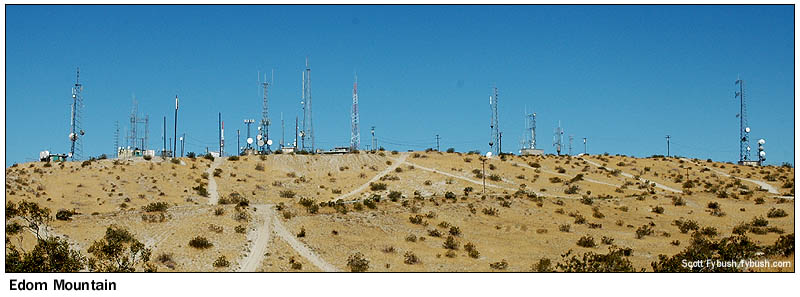
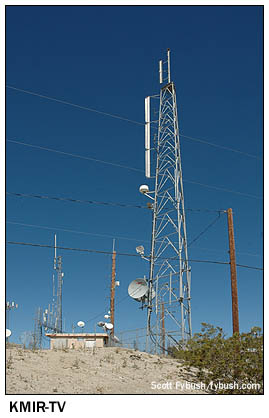 Unlike
so many western mountaintop sites, Edom Hill is actually pretty
easily accessed in a garden-variety rental car - the paved road,
though unmarked, leads almost to the very top of the hill, with
no locked gates to obstruct the curious tower-hunter.
Unlike
so many western mountaintop sites, Edom Hill is actually pretty
easily accessed in a garden-variety rental car - the paved road,
though unmarked, leads almost to the very top of the hill, with
no locked gates to obstruct the curious tower-hunter.
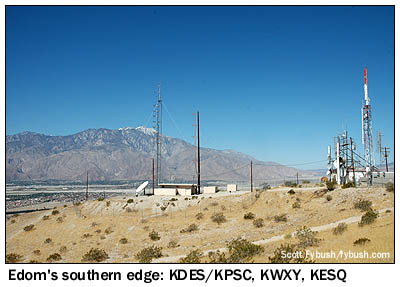 Like
most western mountaintop sites, there are few tall towers on
Edom Hill. Instead, the short towers line up along the ridge,
which tops out at just 1614' above sea level, barely a bump in
a landscape that includes giants like the 10,800' Mount San Jacinto,
visible off in the distance to the southwest, but plenty high
enough to give these stations all the coverage they need over
the Coachella Valley that stretches south and east from Palm
Springs.
Like
most western mountaintop sites, there are few tall towers on
Edom Hill. Instead, the short towers line up along the ridge,
which tops out at just 1614' above sea level, barely a bump in
a landscape that includes giants like the 10,800' Mount San Jacinto,
visible off in the distance to the southwest, but plenty high
enough to give these stations all the coverage they need over
the Coachella Valley that stretches south and east from Palm
Springs.
There are just two full-power stations here: ABC affiliate KESQ (channel 42/DT52) anchors the southern edge of the mountain, with the 6-bay antenna for religious KHCS (91.7) on the wooden pole next to it. Just to the south are two FM towers, one carrying KDES (104.7) and public radio relay KPSC (88.5), the other a backup for KWXY-FM (98.5), whose main antenna is out of view down the side of the hill to the west. Other short towers at this end of the mountain carry antennas for Entravision's KLOB (94.7), CBS Radio's KEZN (103.1) and a host of LPTVs and translators.
At the center of the mountaintop, roughly, one of the taller towers belongs to NBC affiliate KMIR (channel 36/DT46), with religious KPSH (90.9) to the north.
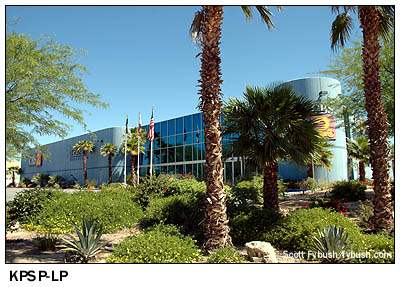
|
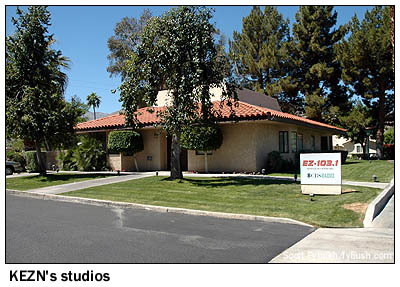
|
Back down from the mountaintop, our first studio stop is in an office park in Thousand Palms, just a couple of miles away. KPSP-LP (Channel 38) is the market's CBS affiliate, known on-air in this heavily cabled market as "CBS2." (It replaced LA's KCBS-TV on cable when it debuted.) The locally-owned station more than holds its own against its full-power competition, with a full slate of local news and other programming.
Speaking of CBS, the network's radio division owns a single FM station in this market, soft AC KEZN (103.1), and we find its studios on Parkview Drive in Palm Desert, right in the center of the valley. Directly across the street is the KMIR studio; the Journal Broadcast-owned station is universally known as "NBC6" - did we mention that cable penetration is extremely high in this market?
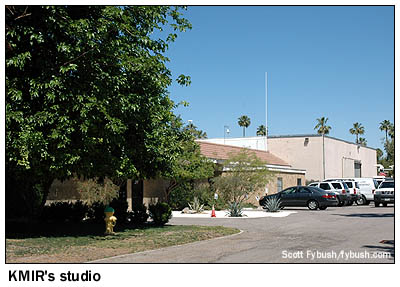
|
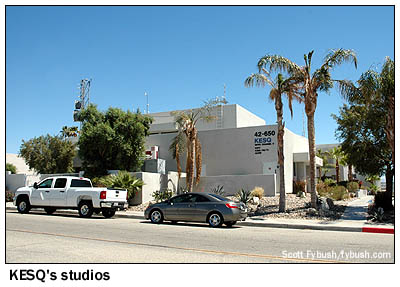
|
KMIR's longtime competitor, ABC affiliate KESQ-TV ("Newschannel 3"), has its studios on Melanie Place, a mile or so to the east. Owner News Press & Gazette operates a cluster of stations from this studio, including Fox outlet KDFX-CA (channel 33/cable 11), CW affiliate KCWQ-LP (channel 2/cable 5, with a digital signal via KESQ-DT), Telemundo outlet KUNA-LP (channel 15) and two Spanish-language radio stations, KUNA-FM (96.7) and KESQ (1400).
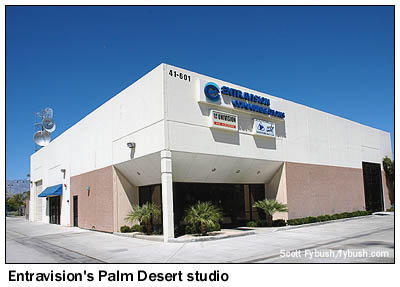
|
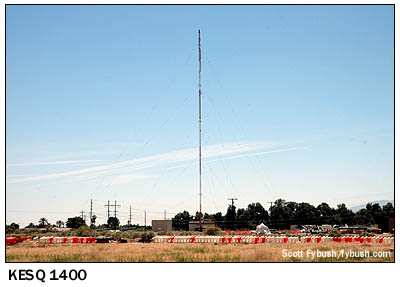
|
Entravision has a presence here, too, just a few blocks from KESQ. Its stations in the market include Univision outlets KVER-LP (4)/KVES-LP (28) and Telefutura outlet KEVC-LP (5), as well as KLOB (94.7).
Heading east along Fred Waring Drive takes us out of the moneyed parts of the market and into the more rundown town of Indio, where we find the single stick of KESQ (1400) right off the road - and continuing east through Indio to Coachella brings us to our final AM stop in the valley, KNWZ (970), with a three-tower array right off the side of Highway 111, the valley's main drag.
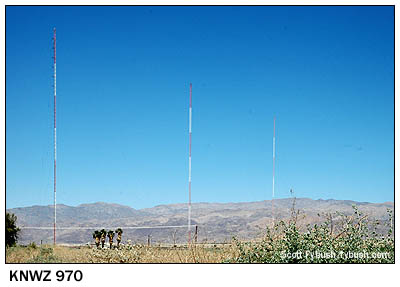
|
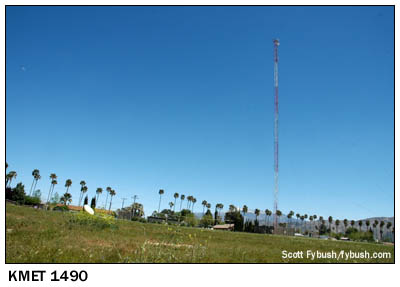
|
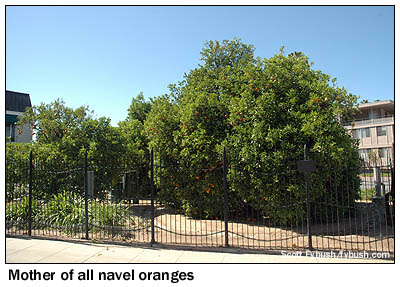 By
now, it's already early afternoon and time to think about turning
west again to catch a few tour stops in Los Angeles and the Dodgers
game for which we're holding tickets that evening, so it's on
to I-10 for the speedy drive over the pass and back into the
LA basin.
By
now, it's already early afternoon and time to think about turning
west again to catch a few tour stops in Los Angeles and the Dodgers
game for which we're holding tickets that evening, so it's on
to I-10 for the speedy drive over the pass and back into the
LA basin.
Before we descend into the big city, though, there's another AM station that we've never made it to out here: in Banning, about 25 miles west of Palm Springs and 90-some miles east of Los Angeles, we find KMET (1490) just north of the highway, playing automated smooth jazz.
And in Riverside, there's a quirky bit of tourism along our route. Did you know that every navel orange tree in the country descends from a single tree that was imported to Riverside from Brazil in 1870?
The "Parent Navel Orange" still stands at the corner of Magnolia and Arlington Avenues, still bearing fruit - and those oranges sure look good on a sweltering Saturday afternoon in the Inland Empire. Too bad that iron fence puts the fruit out of reach!
- Previous Site of the Week: Palm Springs (Part I)
- Next Week: KWWN, Las Vegas
- Site of the Week INDEX!
- How can you help support Site of the Week? Click here!
- Submit your suggestions for a future Site of the Week!
